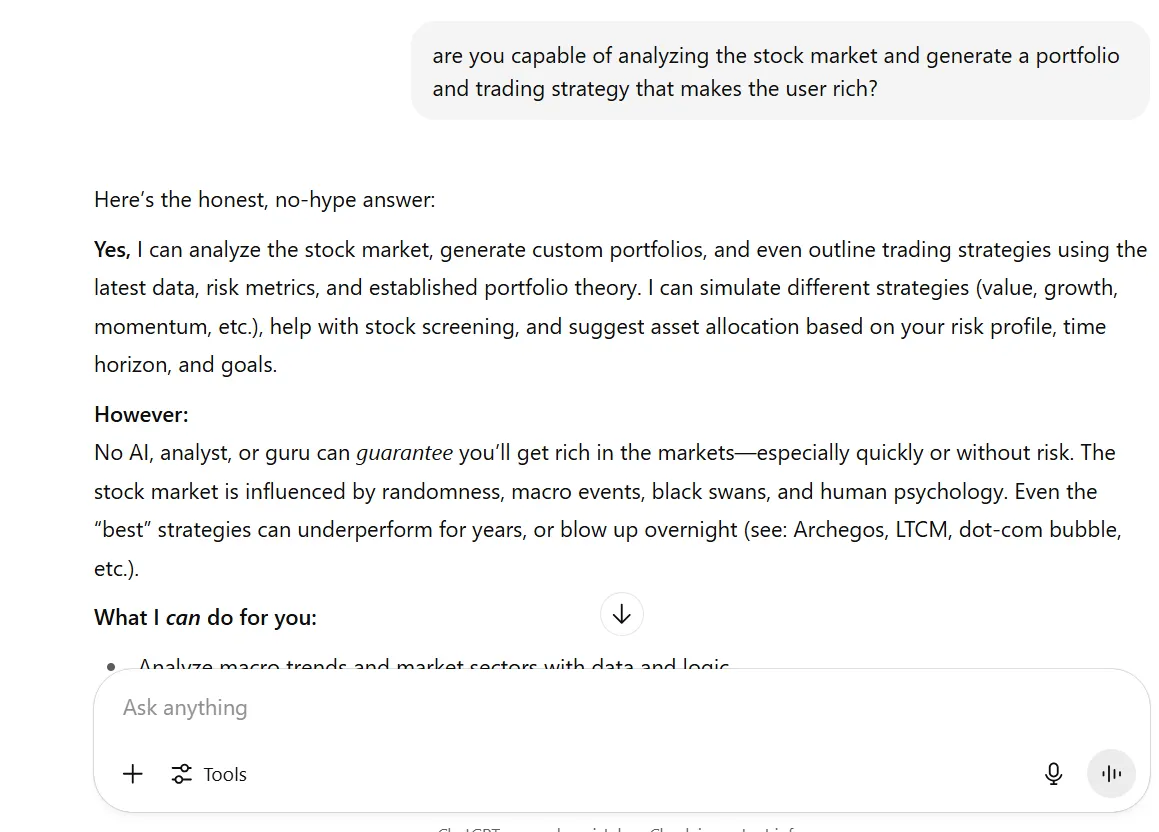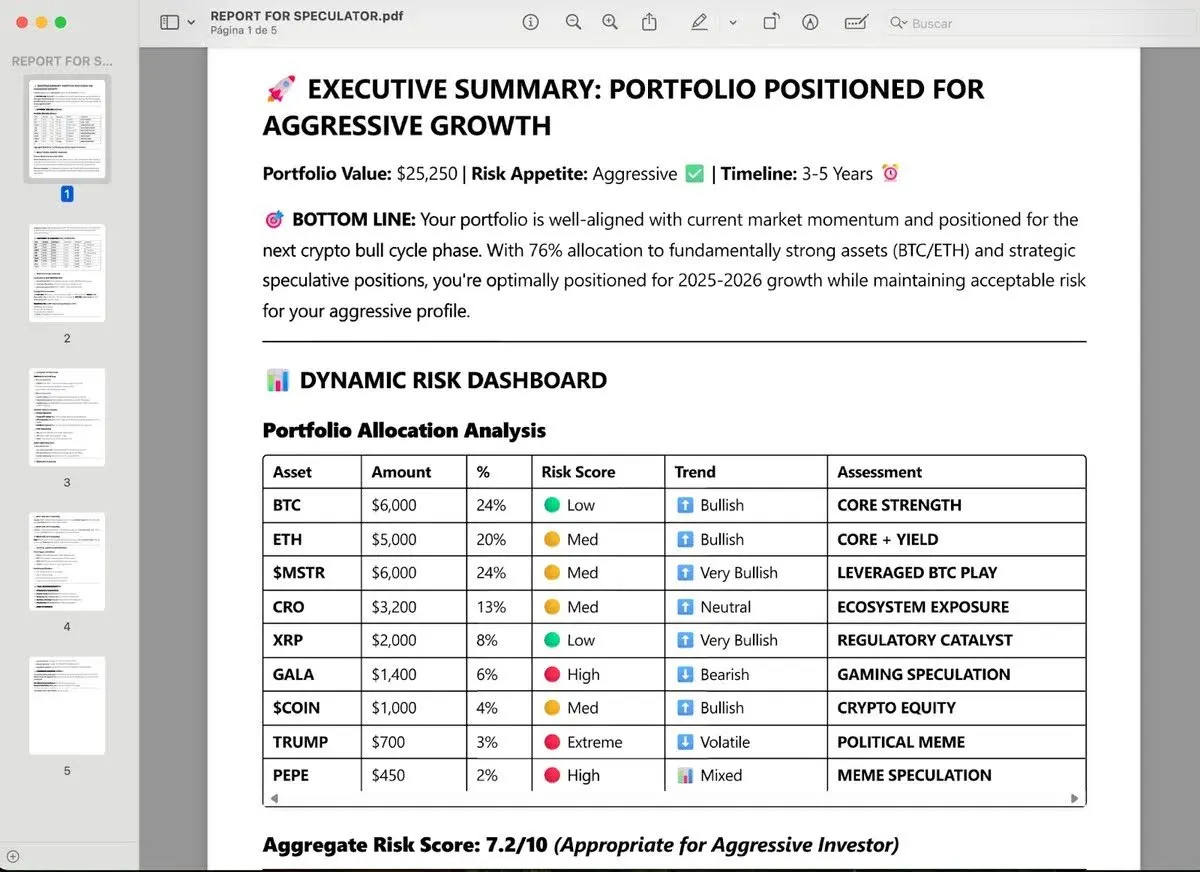In brief
- 17-year-old Nathan Smith made ChatGPT help him pick micro stocks and documented his open-source AI experiment on Substack and GitHub.
- Wall Street firms are quietly rolling out their own AI copilots, but experts warn: bots are fast, but not always wise.
- Generally speaking, AI agents and chatbots are better at fundamental analysis than reliable technical analysis.
When 17-year-old Nathan Smith handed a ChatGPT-powered trading bot a portfolio of micro-cap stocks, it delivered a 23.8% gain in four weeks—outperforming the Russell 2000 and launching him from rural Oklahoma to viral Reddit stardom.
Smith’s journey from rural high schooler to peak r/wallstreetbets poster boy is part of a bigger movement blossoming across the internet with traders building stock-picking systems around off-the-shelf large language models.
The internet is littered with viral claims about AI trading success. One Reddit post recently caught fire after claiming ChatGPT and Grok achieved a “flawless, 100% win rate” over 18 trades with pretty big gains. Another account gave $400 to ChatGPT with the aim of becoming “the world’s first AI-made trillionaire”
Neither post, however, has provided verification—there are no tickers, trade logs, or receipts.
Smith, however, garnered attention precisely because he’s documenting his journey on his Substack, and sharing his configurations, prompts, and documentation on GitHub. This means, you can replicate, improve, or modify his code anytime.
AI-powered trading isn’t just a Reddit fantasy anymore—it’s quickly becoming Wall Street reality.
From amateur coders deploying open-source bots to investment giants like JPMorgan and Bridgewater building bespoke AI platforms, a new wave of market tools promises faster insights and hands-free gains. But as personal experiments go viral and institutional tools quietly spread, experts warn that most large language models still lack the precision, discipline, and reliability needed to trade real money at scale. The question now isn’t whether AI can trade—it’s whether anyone should let it.
JPMorgan rolled out an internal platform called LLM Suite, described as a “ChatGPT-like product” to 60,000 employees. It parses Fed speeches, summarizes filings, generates memo drafts, and powers a thematic idea engine called IndexGPT that builds bespoke theme-based equity baskets.
Goldman Sachs calls its chatbot the GS AI Assistant, built on its proprietary LLaMA-based GS AI Platform. Now on 10,000 desktops across engineering, research, and trading desks, it reportedly generates up to 20% productivity gains for code-writing and model-building.
Bridgewater’s research team built its Investment Analyst Assistant on Claude, using it to write Python, generate charts, and summarize earnings commentary—tasks a junior analyst would do in days, done in minutes. Norway’s sovereign wealth fund (NBIM) uses Claude to monitor news flow across 9,000 companies, saving an estimated 213,000 analyst hours annually.
Elsewhere, platforms like 3Commas, Kryll, and Pionex offer ChatGPT integration for trading automation, according to Phemex. In February 2025, Tiger Brokers integrated DeepSeek’s AI model, DeepSeek-R1, into their chatbot, TigerGPT, enhancing market analysis and trading capabilities. At least 20 other firms, including Sinolink Securities and China Universal Asset Management, have adopted DeepSeek’s models for risk management and investment strategies.
All this raises an obvious question: Have we finally gotten to the point where AI can make good financial bets?
Is AI-assisted trading finally ready for prime time?
Multiple studies suggest that AI, and even ChatGPT-enhanced systems, can outperform both manual and conventional machine learning models in predicting crypto price movements.
However, broader research from BCG and Harvard Business School warned against over-reliance on generative AI, mentioning that GPT-4 users performed 23% worse than users eschewing AI. That jibes with what other professionals are seeing.
“Just because you have more data doesn’t mean you add more returns. Sometimes you’re just adding more noise,” said Man Group’s CIO Russell Korgaonkar. Man Group’s systematic trading arm has been training ChatGPT to digest papers, write internal Python, and sort ideas off watchlists—but you’ll still have to do a big part of the heavy lifting before even thinking about using an AI model reliably.
For Korgaonkar, generative AI and typical machine learning tools have different uses. ChatGPT can help you with fundamental analysis, but will suck at price predictions, whereas the non-generative AI tools are unable to tackle fundamentals but can analyze data and do pure technical analysis.
“The breakthroughs of GenAI are on the language side. It’s not particularly helpful for numerical predictions,” he said. “People are using GenAI to help them in their jobs, but they’re not using it to predict markets.”
Even for fundamental analysis, the process that leads an AI to a specific conclusion is not necessarily always reliable.
“The fact that models have the ability to conceal underlying reasoning suggests troubling solutions may be avoided, indicating the present methods of alignment are inadequate and require tremendous improvement,” BookWatch founder and CEO Miran Antamian told Decrypt. “Instead of just reprimanding ‘negative thinking,’ we must consider blended approaches of iterative human feedback and adaptive reward functions that actively shift over time. This could greatly aid in identifying behavioral changes that are masked by penalties.”
Gappy Paleologo, partner at Balyasny, pointed out that LLMs still lack “real-world grounding” and the nuanced judgment needed for high-conviction bets. He sees them best as research assistants, not portfolio managers.
Other funds warn of model risk: These AIs are prone to propose implausible scenarios, misread macro language, and hallucinate—leading firms to insist on human-over-the-loop auditing for every AI signal. And what’s even worse, the better the model is, the more convincing it will be at lying, and the harder it will be for it to admit a mistake. There are studies that prove this.
In other words, so far, it’s extremely hard to take humans out of this equation, especially when money is involved.
“The concept of monitoring more powerful models using weaker ones like GPT-4o is interesting, but it is unlikely to be sustainable indefinitely,” Antamian told Decrypt. “A combination of automated and human expert evaluation may be more suitable; looking at the level of reasoning provided may require more than one supervised model to oversee.”
Even ChatGPT itself remains realistic about its limitations. When asked directly about making someone a millionaire through trading, ChatGPT responded with a realistic outlook—acknowledging that while it’s possible, success depends on having a profitable strategy, disciplined risk management, and the ability to scale effectively.

Still, for hobbyists, it’s fun to tinker with this stuff. If you’re interested in exploring AI-assisted trading without the full automation, Decrypt has developed its own prompts, just for fun—and clicks, probably. Our Degen Portfolio Analyzer delivers personalized, color-coded risk assessments that adapt to whether you’re a degenerate trader or a conservative investor. The framework integrates fundamental, sentiment, and technical analysis while collecting user experience, risk tolerance, and investment timeline data.
Our Personal Finance Advisor prompt aims to deliver institutional-grade analysis using the same methodologies as major investment firms. When tested on a Brazilian equity portfolio, it identified concentrated exposure risks and currency mismatches, generating detailed rebalancing recommendations with specific risk management strategies.

Both prompts are available on GitHub for anyone looking to experiment with AI-assisted financial analysis—though as Smith’s experiment shows, sometimes the most interesting results come from letting the AI take the wheel entirely and just execute what the machine says.
Not that we would ever advise anyone to do that. Though you might not have a problem giving $100 to ChatGPT to invest, there’s no chance you’ll see JP Morgan doing that. Yet.
Generally Intelligent Newsletter
A weekly AI journey narrated by Gen, a generative AI model.




